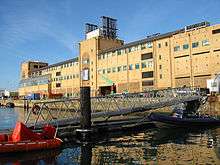National Oceanography Centre
 | |
| Abbreviation | NOC |
|---|---|
| Formation | April 1, 2010 |
| Legal status | Government Organisation |
| Purpose | Ocean Research and Technological Development |
| Headquarters | Southampton |
Region served |
|
Executive Director | Professor Ed Hill, OBE |
Main organ | NOC Advisory Council |
Parent organization | Natural Environment Research Council |
| Affiliations | |
| Website | www.noc.ac.uk |
The National Oceanography Centre (NOC) is a marine science research and technology institution based on two sites in Southampton and Liverpool, United Kingdom. It is the UK’s largest institution for integrated sea level science, coastal and deep ocean research and technology development.[1]
The NOC is wholly owned by the Natural Environment Research Council (NERC) and was formed in April 2010 by bringing together the NERC-managed activity at the National Oceanography Centre, Southampton and Liverpool’s Proudman Oceanographic Laboratory.
The centre was set up to work in close partnership with institutions across the UK marine science community to address key science challenges, including sea level change, the oceans’ role in climate change, predicting and simulating the behaviour of the oceans through computer modelling, the future of the Arctic Ocean and long-term monitoring technologies.
Marine science national capability
The NOC provides the bulk of the UK’s capability to meet the needs of the country’s marine research community.
National marine capability provided by the NOC includes Royal Research Ships, RRS James Cook and RRS Discovery, deep submersibles, including the Autosub autonomous underwater vehicles (AUVs), advanced ocean sensors and other instruments.
Across its two sites, the National Oceanography Centre is responsible for the global mean sea level data archive, the UK’s sea level monitoring system for flood warning and climate change, the national archive of subsea sediment cores (British Ocean Sediment Core Research Facility), the National Oceanographic Library, which houses the nationally important RRS Discovery and HMS Challenger archives, and the UK’s main facility for holding and distributing data concerning the marine environment.
History

The National Oceanography Centre’s waterfront headquarters were opened in 1996 by HRH the Duke of Edinburgh, as the Southampton Oceanography Centre. It brought together the University of Southampton's departments of oceanography and geology with the Institute of Oceanographic Sciences, formerly based in Wormley, Surrey, and Research Vessel Services, formerly based in Barry Docks, South Wales.
It was renamed the National Oceanography Centre, Southampton in 2005, again by HRH the Duke of Edinburgh, its new name reflecting its prominence in ocean and earth sciences within the UK.
Until April 2010, the National Oceanography Centre, Southampton was jointly owned by the University of Southampton and the Natural Environment Research Council. The term National Oceanography Centre, Southampton continues to be used to describe the collaborative relationship at the waterfront campus.
The National Oceanography Centre’s Liverpool site, on the University of Liverpool campus, was formerly the Proudman Oceanographic Laboratory and specialises in tidal and sea level science. It hosts the National Tidal and Sea Level Facility, the Permanent Service for Mean Sea Level and the British Oceanographic Data Centre. It was formerly housed at the Bidston Observatory on the Wirral before moving to the University of Liverpool campus in 2004. It maintained a popular web presence displaying realtime weather and ocean data, but since mid 2013 has failed to continue to maintain these services.
NOC Association
The NOC is at the centre of a strategic network of partners and associates - at universities and research institutes - working collaboratively with the Centre in its support of world-class research, technology development and training the scientists of the future. Together, these organisations form the NOC Association, sharing in the delivery of the NERC’s marine science priorities.
Partners
The NOC’s partners include the University of Southampton, whose Ocean and Earth Science academic unit is co-located at the NOC’s dockside headquarters, home to around 520 research scientists, engineers and technicians, ship operations and support staff, as well as around 700 undergraduate and postgraduate students. The University of Liverpool is the NOC’s other hosting partner and postgraduate students are taught in a research-led environment in NOC's Joseph Proudman Building on the university's campus.
The NOC is responsible for managing UK marine science national capability. This includes provision of major facilities, programmes of sustained observing, survey, mapping, data management and other functions. The NOC also manages contracts placed by NERC with other organisations to provide some national capability functions. Such organisations are known as Delivery Partners and include:
- Plymouth Marine Laboratory
- Scottish Association for Marine Science
- British Antarctic Survey
- British Geological Survey
- Marine Biological Association
- Sir Alistair Hardy Foundation for Ocean Science (named after Alistair Hardy)
The centre is committed to international engagement and has developed a range of international partnerships through the International and Strategic Partnerships Office, including an alliance of Europe’s three principal oceanographic research institutions with Ifremer of France and IFM Geomar of Germany.
The NOC is a member of the European Global Ocean Observing System (EuroGOOS)[2]
References
- ↑ "National Oceanography Centre: NERC 2005 Press Release". National Oceanography Centre. Retrieved 30 June 2011.
- ↑ "Natural Environment Research Council (NERC) / National Oceanography Centre (NOC) - EuroGOOS". EuroGOOS. Retrieved 27 April 2016.
- "History of National Institute of Oceanography". National Oceanography Centre. Retrieved 9 September 2016.
External links
Coordinates: 50°53′34″N 1°23′41″W / 50.89286°N 1.39481°W